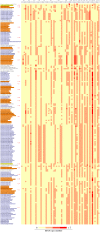Global In-Silico Scenario of tRNA Genes and Their Organization in Virus Genomes
- PMID: 30795514
- PMCID: PMC6409571
- DOI: 10.3390/v11020180
Global In-Silico Scenario of tRNA Genes and Their Organization in Virus Genomes
Abstract
Viruses are known to be highly dependent on the host translation machinery for their protein synthesis. However, tRNA genes are occasionally identified in such organisms, and in addition, few of them harbor tRNA gene clusters comprising dozens of genes. Recently, tRNA gene clusters have been shown to occur among the three domains of life. In such a scenario, the viruses could play a role in the dispersion of such structures among these organisms. Thus, in order to reveal the prevalence of tRNA genes as well as tRNA gene clusters in viruses, we performed an unbiased large-scale genome survey. Interestingly, tRNA genes were predicted in ssDNA (single-stranded DNA) and ssRNA (single-stranded RNA) viruses as well in many other dsDNA viruses of families from Caudovirales order. In the latter group, tRNA gene clusters composed of 15 to 37 tRNA genes were characterized, mainly in bacteriophages, enlarging the occurrence of such structures within viruses. These bacteriophages were from hosts that encompass five phyla and 34 genera. This in-silico study presents the current global scenario of tRNA genes and their organization in virus genomes, contributing and opening questions to be explored in further studies concerning the role of the translation apparatus in these organisms.
Keywords: bacteriophages; codons; host range; ssDNA; ssRNA; tRNA gene; tRNA gene cluster; translation apparatus; virus.
Conflict of interest statement
The authors declare that the research was conducted in the absence of any commercial or financial relationships that could be construed as a potential conflict of interest.
Figures


Similar articles
-
Xanthomonas citri jumbo phage XacN1 exhibits a wide host range and high complement of tRNA genes.Sci Rep. 2018 Mar 14;8(1):4486. doi: 10.1038/s41598-018-22239-3. Sci Rep. 2018. PMID: 29540765 Free PMC article.
-
Exploring tRNA gene cluster in archaea.Mem Inst Oswaldo Cruz. 2019 Jan 7;114:e180348. doi: 10.1590/0074-02760180348. Mem Inst Oswaldo Cruz. 2019. PMID: 30624459 Free PMC article.
-
Diversity of tRNA Clusters in the Chloroviruses.Viruses. 2020 Oct 16;12(10):1173. doi: 10.3390/v12101173. Viruses. 2020. PMID: 33081353 Free PMC article.
-
Evolution of double-stranded DNA viruses of eukaryotes: from bacteriophages to transposons to giant viruses.Ann N Y Acad Sci. 2015 Apr;1341(1):10-24. doi: 10.1111/nyas.12728. Epub 2015 Feb 27. Ann N Y Acad Sci. 2015. PMID: 25727355 Free PMC article. Review.
-
Single-stranded DNA viruses employ a variety of mechanisms for integration into host genomes.Ann N Y Acad Sci. 2015 Apr;1341:41-53. doi: 10.1111/nyas.12675. Epub 2015 Feb 11. Ann N Y Acad Sci. 2015. PMID: 25675979 Review.
Cited by
-
Characterization of Two New Shiga Toxin-Producing Escherichia coli O103-Infecting Phages Isolated from an Organic Farm.Microorganisms. 2021 Jul 17;9(7):1527. doi: 10.3390/microorganisms9071527. Microorganisms. 2021. PMID: 34361962 Free PMC article.
-
Characterization and Genome Study of Novel Lytic Bacteriophages against Prevailing Saprophytic Bacterial Microflora of Minimally Processed Plant-Based Food Products.Int J Mol Sci. 2021 Nov 18;22(22):12460. doi: 10.3390/ijms222212460. Int J Mol Sci. 2021. PMID: 34830335 Free PMC article.
-
On the Track of the Missing tRNA Genes: A Source of Non-Canonical Functions?Front Mol Biosci. 2021 Mar 16;8:643701. doi: 10.3389/fmolb.2021.643701. eCollection 2021. Front Mol Biosci. 2021. PMID: 33796548 Free PMC article. Review.
-
A Cocktail of Three Virulent Phages Controls Multidrug-Resistant Salmonella Enteritidis Infection in Poultry.Front Microbiol. 2022 Jul 6;13:940525. doi: 10.3389/fmicb.2022.940525. eCollection 2022. Front Microbiol. 2022. PMID: 35875532 Free PMC article.
-
Simultaneous entry as an adaptation to virulence in a novel satellite-helper system infecting Streptomyces species.ISME J. 2023 Dec;17(12):2381-2388. doi: 10.1038/s41396-023-01548-0. Epub 2023 Oct 31. ISME J. 2023. PMID: 37907733 Free PMC article.
References
-
- Abrahão J., Silva L., Silva L.S., Khalil J.Y.B., Rodrigues R., Arantes T., Assis F., Boratto P., Andrade M., Kroon E.G., et al. Tailed giant Tupanvirus possesses the most complete translational apparatus of the known virosphere. Nat. Commun. 2018;9:749. doi: 10.1038/s41467-018-03168-1. - DOI - PMC - PubMed
Publication types
MeSH terms
Substances
LinkOut - more resources
Full Text Sources

